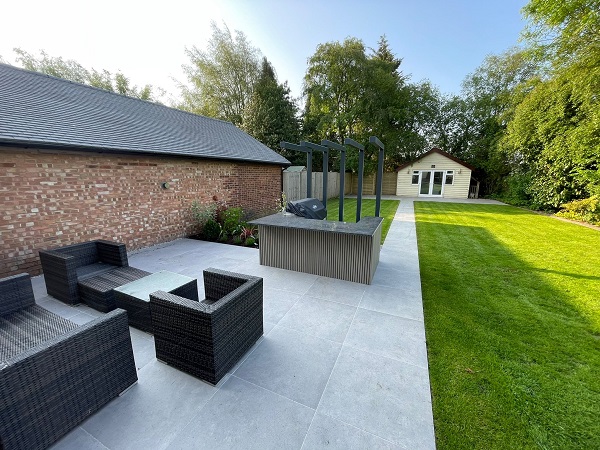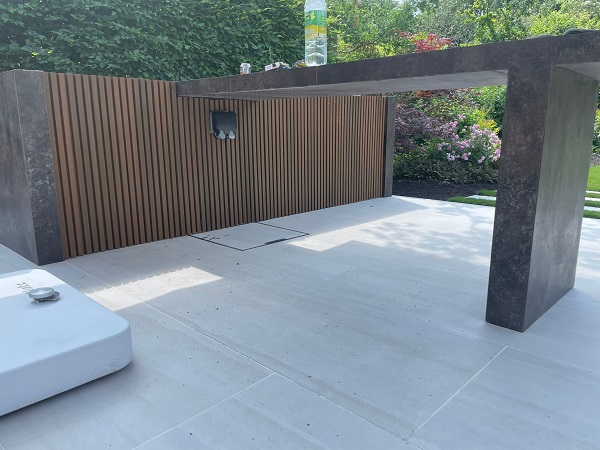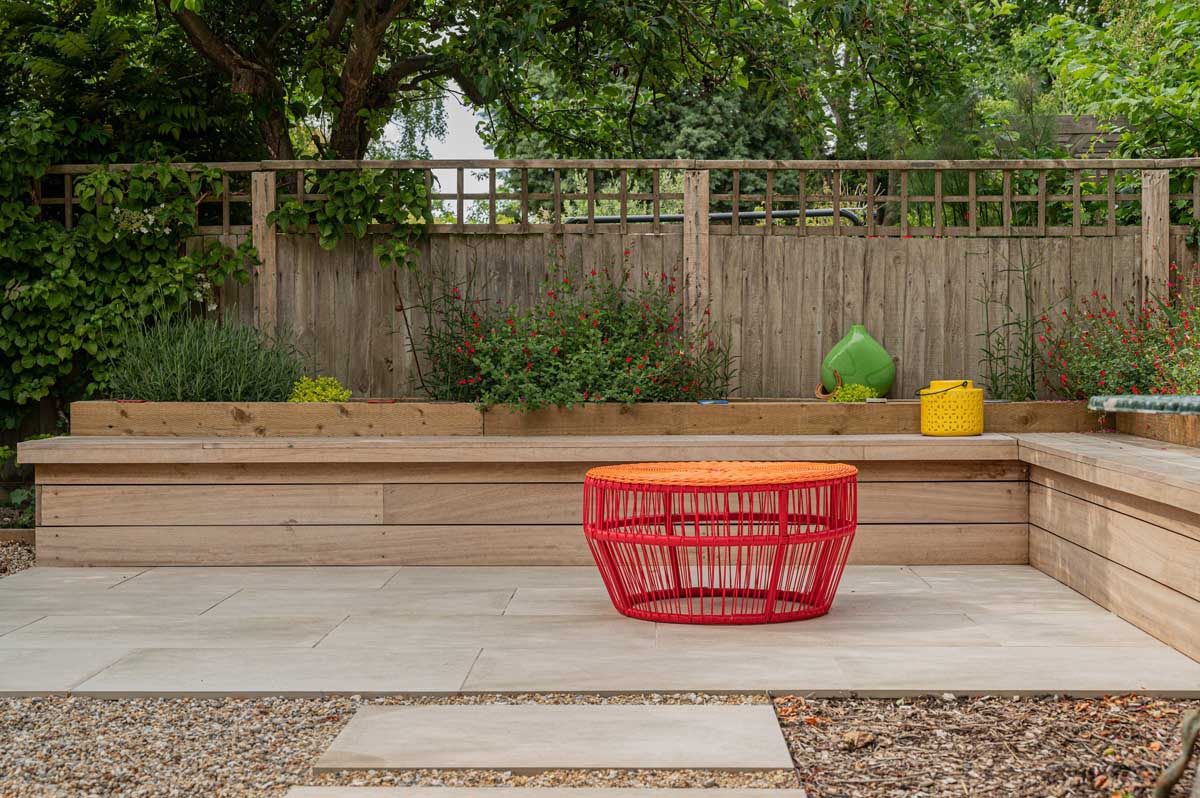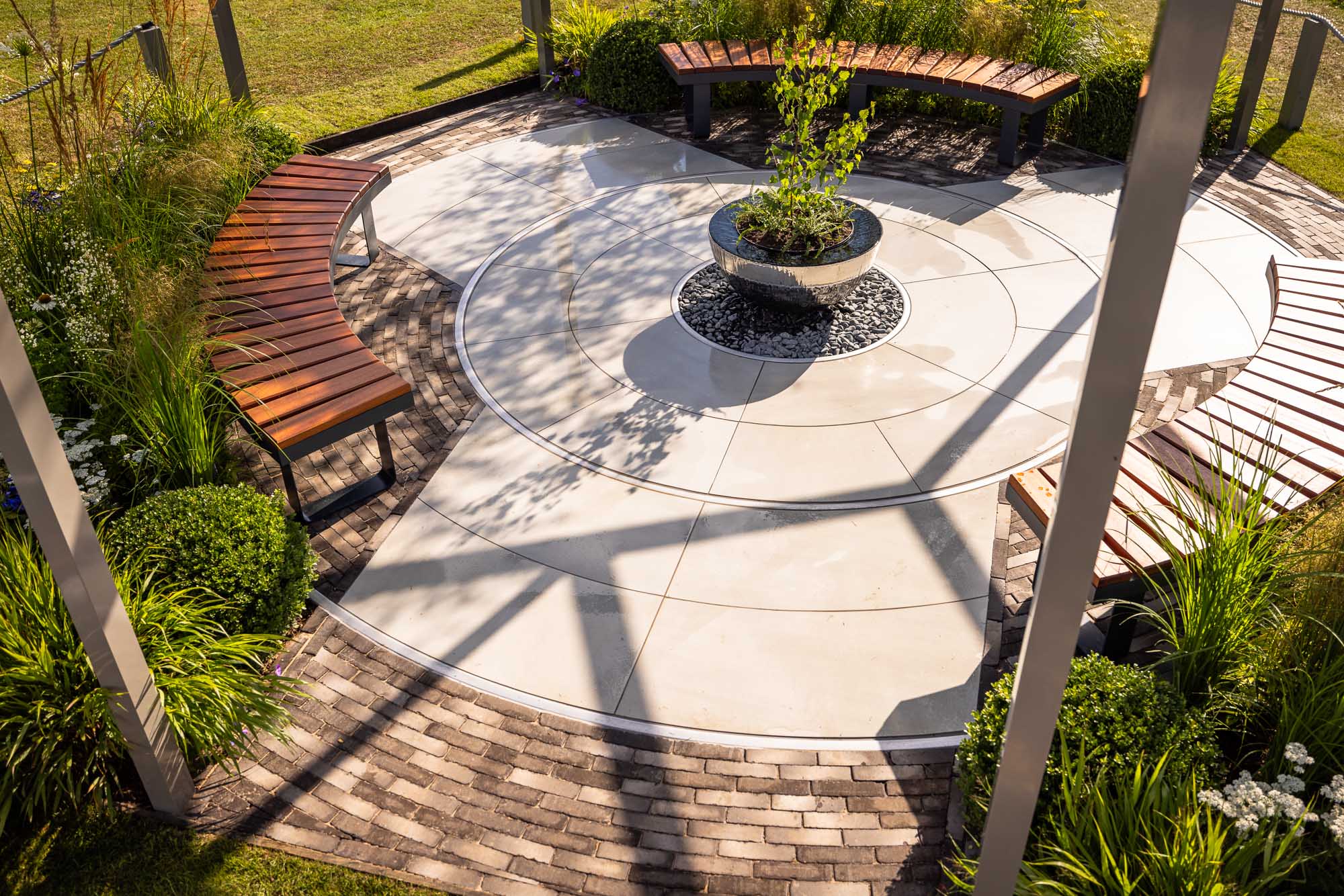In theory, laying paving on top of concrete seems like a great idea. A concrete base offers a strong platform, after all. However, care should be taken. We look at when it works, and when it doesn't.

Laying slabs on concrete the professional way
Stuart Reid, of Landscapes By Design in Essex, always lays on a concrete base, whether he’s putting down porcelain outdoor tiles or natural stone. “It’s based on where we live” he says. “This is a very clay-based area, and with the increasing extreme rain and hot temperatures the ground will move with drying out (cracking) and heave (swelling).’’
Concrete on clay soil
In order to compensate for possible ground movement, which could result in slabs being displaced, Stuart takes what he describes as “a belt and braces” approach. “I’m not saying it’s the only way or any better than others, I’m trying to future proof for our clients and don’t want to re visit because the patio has moved.”
Stuart will excavate the base, lay geotextile membrane, top it with 50-100mm of MOT type 1, compact and then lay the concrete base. The concrete has A142 reinforcement mesh embedded in it and he also puts geogrid matting into the laying bed as a secondary back up defence against cracking. This provides a really solid base that can cope with movement in the ground.
Does a concrete base need an expansion joint?
Sometimes it is suggested that an expansion joint should be used with a concrete base, but Stuart disagrees. “I keep it all knitted together as one. If you put in an expansion joint this will need to be brought through to the paving as well, which is not an attractive look, and let’s be honest it is all about how it looks.”

Lay pavers on concrete with adhesive
When laying tiles, Stuart uses a 10mm notched rapid-setting tile adhesive as a bridging bond. This means that if there’s any pulling when levelling out the slabs on the laying bed, the adhesive stretches before it goes off, and there’s no danger of slabs rocking. Even on a solid full sand cement bed, with the small bend in most tiles it gives confidence in full adhesion.
Is laying slabs on concrete something that Stuart thinks will become increasingly popular? “It has to.” he says. “With high temperatures drying out the ground quickly and then heavy rain can cause heave. It’s a must for Landscapes By Design."
It’s not just about being practical, though. As you can see from the pictures, the finish created on such a firm foundation is something to admire.
An unusual reason to lay paving slabs over concrete
Some time ago a paving contractor contacted us. He was installing a Yorkstone patio and the project architect had specified that the slabs should be laid on a concrete base.
At first, this case had all the hallmarks of an over-zealous architect. However, it turned out that beneath the proposed paved area are natural springs. The architect was concerned that the springs could erode and undermine a standard MOT base.
So, we concurred with laying on concrete and told the contractor that he should seal the underside of the paving to prevent moisture from leaching through the slabs. This is something very particular to this case, as normally you should never seal the underside of slabs. If for any reason you have to, you should use a bond bridge to help slabs adhere to the bed.
When not to lay a patio on concrete
You've moved into a new house and the patio is a dingy slab of concrete. No one wants to take up concrete if you don’t have to, so it's tempting to lay slabs straight down on an existing base. We look at potential pitfalls that would result in the failure of your paving:
Inadequate drainage
If the existing concrete base is flat, it may not provide proper drainage. Water can accumulate, which could lead to damage over time.
If the concrete is sloped, it's important to make sure the surface slopes down to adequate drainage.

Uneven surface
If the concrete is uneven, this will lead to difficulty laying the slabs and create an uneven surface. This not only poses a tripping hazard but could also lead to instability in the paving slabs over time. This could lead to cracking or movement of the paving slabs.
Concrete deterioration
If the concrete is cracked, deteriorating, or has frost heaves, paving over them will just hide the problem. The stability of your paving slabs will almost certainly be compromised.
Insufficient load bearing
If the concrete is not of sufficient depth or quality, it may not withstand the weight of the paving slabs plus any additional load (e.g. vehicles, if it's a driveway). This can lead to damage over time.
The problems may not just lie with the condition of the base itself. Putting slabs down on concrete creates other problems.
Slabs of a variable thickness
Riven Indian sandstone paving slabs have a tolerance of up to +5/-5 mm. This means that there could be a difference in thickness between one slab and another of 10mm. Even sawn stone has a +2/-2mm tolerance. The only material without a tolerance is our rectified porcelain paving.
We often receive calls from clients whose contractors have installed a concrete base. The contractors will have allowed for a paving depth of 22mm and not taken into account the fact that the paving can be as thick as 27mm.
Differences in height may, not only create a problem for slabs of different thickness, but they may even mean the finished height of the paving breaches the damp course.
Water becomes trapped beneath slabs
If water makes its way under the slabs, it’ll become trapped, causing damp spots in the paving. An MOT base allows trapped water to drain easily away.
So, there you have it. Laying paving slabs on concrete can give a great finish and the peace of mind of long-lasting stability on difficult ground. But don't cut corners to do it. Covering over an old concrete base is likely to cause problems in the future.
Considering how to lay your patio? Find out more about laying outdoor tiles on an aggregate base.
Post updated: June 2023


/filters:quality(60)/mediadev/media/menu-pics/all-porcelain.jpg )
/filters:quality(60)/mediadev/media/menu-pics/luxury-italian.jpg )
/filters:quality(60)/mediadev/media/menu-pics/premium-italian.jpg )
/filters:quality(60)/mediadev/media/menu-pics/budget-porcelain.jpg )
/filters:quality(60)/mediadev/media/menu-pics/large-format-porcelain.jpg )
/filters:quality(60)/mediadev/media/menu-pics/wood-effect-porcelain.jpg )
/filters:quality(60)/mediadev/media/menu-pics/porcelain-planks.jpg )
/filters:quality(60)/mediadev/media/menu-pics/porcelain-setts.jpg )
/filters:quality(60)/mediadev/media/menu-pics/browse-all-paving.jpg )
/filters:quality(60)/mediadev/media/menu-pics/stone-paving.jpg )
/filters:quality(60)/mediadev/media/menu-pics/interior-tiles.jpg )
/filters:quality(60)/mediadev/media/menu-pics/stone-effect-porcelain.png )
/filters:quality(60)/mediadev/media/menu-pics/wood-effect-porcelain.png )
/filters:quality(60)/mediadev/media/menu-pics/grey-porcelain.png )
/filters:quality(60)/mediadev/media/menu-pics/beige-porcelain.png )
/filters:quality(60)/mediadev/media/menu-pics/dark-porcelain.png )
/filters:quality(60)/mediadev/media/menu-pics/light-porcelain.png )
/filters:quality(60)/mediadev/media/menu-pics/patio-grout.jpg)
/filters:quality(60)/mediadev/media/menu-pics/primers.jpg)
/filters:quality(60)/mediadev/media/menu-pics/porcelain-blades.jpg)
/filters:quality(90)/mediadev/media/menu-pics/drainage.jpg)
/filters:quality(60)/mediadev/media/menu-pics/cleaners.jpg)
/filters:quality(60)/mediadev/media/menu-pics/all-stone-paving.jpg )
/filters:quality(60)/mediadev/media/menu-pics/all-sawn-paving.jpg )
/filters:quality(60)/mediadev/media/menu-pics/all-riven-paving.jpg )
/filters:quality(60)/mediadev/media/menu-pics/indian-sandstone.jpg )
/filters:quality(60)/mediadev/media/menu-pics/limestone-paving.jpg )
/filters:quality(60)/mediadev/media/menu-pics/granite-paving.jpg )
/filters:quality(60)/mediadev/media/menu-pics/slate-paving.jpg )
/filters:quality(60)/mediadev/media/menu-pics/yorkstone-paving.jpg )
/filters:quality(60)/mediadev/media/menu-pics/stone-pavers.jpg )
/filters:quality(60)/mediadev/media/menu-pics/cobbles-setts.jpg )
/filters:quality(60)/mediadev/media/menu-pics/plank-paving.jpg )
/filters:quality(60)/mediadev/media/menu-pics/paving-circles.jpg )
/filters:quality(60)/mediadev/media/menu-pics/bespoke-paving-1.jpg )
/filters:quality(60)/mediadev/media/menu-pics/edging-stones-1.jpg )
/filters:quality(60)/mediadev/media/menu-pics/prestige-stone.jpg )
/filters:quality(60)/mediadev/media/menu-pics/grey-blue-stone.png)
/filters:quality(60)/mediadev/media/menu-pics/swatch-black-dark.jpg )
/filters:quality(60)/mediadev/media/menu-pics/swatch-buff-beige-white.jpg )
/filters:quality(60)/mediadev/media/menu-pics/sealants.jpg)
/filters:quality(60)/mediadev/media/menu-pics/all-clay-paving.jpg )
/filters:quality(60)/mediadev/media/menu-pics/alpha-clay-pavers.jpg )
/filters:quality(60)/mediadev/media/menu-pics/cottage-garden-clay-pavers.jpg )
/filters:quality(60)/mediadev/media/menu-pics/kessel-garden-clay-pavers.jpg )
/filters:quality(60)/mediadev/media/menu-pics/artisan-clay-pavers.jpg )
/filters:quality(60)/mediadev/media/menu-pics/grey-blue-clay-paver.png )
/filters:quality(60)/mediadev/media/menu-pics/red-brown-clay-pavers.png )
/filters:quality(60)/mediadev/media/menu-pics/beige-buff-clay-pavers.png )
/filters:quality(60)/mediadev/media/menu-pics/composite-decking.jpg )
/filters:quality(60)/mediadev/media/menu-pics/designboard-decking.jpg )
/filters:quality(60)/mediadev/media/menu-pics/classic-designboard.jpg )
/filters:quality(60)/mediadev/media/menu-pics/brushed-designboard.jpg )
/filters:quality(60)/mediadev/media/menu-pics/grooved-designboard.jpg )
/filters:quality(60)/mediadev/media/menu-pics/millboard-decking.jpg )
/filters:quality(60)/mediadev/media/menu-pics/grey-decking.jpg )
/filters:quality(60)/mediadev/media/menu-pics/black-charcoal-decking.jpg)
/filters:quality(60)/mediadev/media/menu-pics/brown-decking.jpg)
/filters:quality(60)/mediadev/media/menu-pics/all-build-deck.png )
/filters:quality(60)/mediadev/media/menu-pics/stone-cladding.jpg )
/filters:quality(60)/mediadev/media/menu-pics/all-garden-walling-1.jpg )
/filters:quality(60)/mediadev/media/menu-pics/facing-bricks.jpg )
/filters:quality(60)/mediadev/media/menu-pics/garden-screening.jpg )
/filters:quality(60)/mediadev/media/menu-pics/all-steps-coping.jpg )
/filters:quality(60)/mediadev/media/menu-pics/stone-garden-steps.jpg )
/filters:quality(60)/mediadev/media/menu-pics/sawn-steps.jpg )
/filters:quality(60)/mediadev/media/menu-pics/riven-steps.jpg )
/filters:quality(60)/mediadev/media/menu-pics/yorkstone-steps.jpg )
/filters:quality(60)/mediadev/media/menu-pics/bespoke-steps.jpg )
/filters:quality(60)/mediadev/media/menu-pics/porcelain-steps.jpg )
/filters:quality(60)/mediadev/media/menu-pics/off-the-shelf.jpg )
/filters:quality(60)/mediadev/media/menu-pics/stone-coping.jpg )
/filters:quality(60)/mediadev/media/menu-pics/sawn-coping.jpg )
/filters:quality(60)/mediadev/media/menu-pics/riven-coping.jpg )
/filters:quality(60)/mediadev/media/menu-pics/yorkstone-coping.jpg )
/filters:quality(60)/mediadev/media/menu-pics/bespoke-coping.jpg )
/filters:quality(60)/mediadev/media/menu-pics/stone-pier-caps.jpg )
/filters:quality(60)/mediadev/media/menu-pics/porcelain-coping.jpg )
/filters:quality(60)/mediadev/media/menu-pics/all-bespoke-services.jpg )
/filters:quality(60)/mediadev/media/menu-pics/bespoke-paving-2.jpg )
/filters:quality(60)/mediadev/media/menu-pics/bespoke-steps-1.jpg )
/filters:quality(60)/mediadev/media/menu-pics/bespoke-coping-1.jpg )
/filters:quality(60)/mediadev/media/menu-pics/edge-profiles.jpg )
/filters:quality(60)/mediadev/media/menu-pics/masonry-services.jpg )
/filters:quality(60)/mediadev/media/menu-pics/deluxe-pergolas.jpg )
/filters:quality(60)/mediadev/media/menu-pics/proteus-pergolas.jpg )




